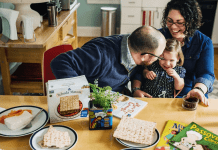My husband and I have walked into my late mother-in-law’s house for the last time.
We are in the process of settling her estate, including the sale of her house and disposition of everything in it.
From a hutch filled with china and crystal goblets to overflowing jewelry boxes and coin collections. And everything in between.
A lot in between.
Her clothes. The Notre Dame sweaters my late father-in-law was so fond of wearing. Her furniture. Furniture inherited from her mother-in-law, still in the same place in the garage where it was originally placed 30 some-odd years ago. My husband’s Cub Scout uniform. Christmas decorations. Lots and lots of Christmas decorations.
Every room, every closet, every shelf, every drawer. Full of stuff. A lifetime of stuff. Two lifetimes, if you count my father-in-law, who passed away 11 years ago.
What to Do With a Lifetime of Stuff
My mother-in-law was a neat and tidy housekeeper. But like many of us (myself included), she lived in a good-sized house with plenty of room to accommodate stuff. Things inherited from her parents and her in-laws. The broken vacuum cleaner waiting for repair in the back of the closet. Hundreds of books read once. You get the picture.
And the cost of disposing of all of that stuff? Having the estate sale company we hired go through every room, every closet, every drawer, separating the trash from the treasures, may cost more than will be generated at the eventual estate sale.
Her house has been transformed into a store, the estate sale company having cleverly arranged and displayed my mother-in-law’s possessions on tables in every room.
All of her possessions with any value, save the very few we kept, each with a tiny white price tag.
Losing your last surviving parent is hard enough. But being the arbiter of which of your parents’ and grandparents’ treasures get saved and which end up sold, donated, or in a landfill? gut-wrenching.
The lesson we have learned from this experience?
Most of the stuff in your house is worthless. And eventually, someone, either you or your kids, will be tasked with the overwhelming job of getting rid of it.
Most of Your Stuff Is Worthless
Most of the stuff in your house is worthless.
Yes, even the stuff you worry the most about, the stuff you think is so good you don’t use it for fear of breaking it, has little to no resale value.
From china, china cabinets, crystal goblets, silver tea sets, pianos, and collectible figurines like Hummels, to grandfather clocks and real pieces of craftsmanship furniture.
Why? Baby boomers have glutted the market with their castoffs, and millennials, the next generation of buyers, don’t want it.
Millennials hate both formal in-home entertaining and use of second-hand goods. With looming student loans, they tend to rent and move often. Who wants to be constantly moving a piano and a grandfather clock from apartment to apartment?
And furniture? There’s no market for so-called “brown furniture,” meaning any furniture (regardless of quality) other than the “mid-century casual” furniture (think clean, lightweight) favored by millennials. Brown furniture is basically firewood.
If it’s not in great condition, it’s also not fit for donation because it can’t be resold.
All of my mother-in-law’s furniture (including the pieces inherited from her mother-in-law and kept for decades)? Straight to the landfill.
Well, Almost Everything…
What do guns, LPs (records), and precious metals/gems have in common?
They are 3 things you might have in your house with a robust resale value.
Silverware also has value, but only if it is real silver and can be melted down.
3 Things You Should Be Doing NOW to Reduce the Amount of Stuff You Have
1. Be viciously thoughtful about holding onto sentimental items.
Here was our goal with sorting through my mother-in-law’s things. Keep just enough to remind us of her, but not so much stuff that our daughters are going to be dealing with it 40 some-odd years from now.
Here’s what we kept:
- A painting to be displayed in our dining room
- My mother-in-law’s treasured Swarovski crystal animal collection (all of which were given to her by her children and grandchildren over the years)
- Jewelry to be divided among the granddaughters
- Each of our daughters got to select 1 item
And that was it.
Well, almost. We did set aside photos to be digitized (with the originals then destroyed).
Was it hard leaving everything else? You bet it was. But we don’t want to be dealing with a lot of stuff years from now (or worse, leaving it to our daughters to deal with).
I try to be viciously thoughtful with my own sentimental items. For example, I don’t save any school papers or art projects from my kids (though I do take photos of my favorites).
2. Buy fewer books.
While used book resellers like Half Price Books do an important service in keeping books in circulation, a surprising number of books end up in landfills because many paper recycling facilities can’t process the the glue that binds book spines.
My resolution last year was to cut down on my book consumption by only reading books that I borrow from the library or purchase on my Kindle e-reader. If you haven’t used a library in years, now is the time to go back. My local library has an app where you can “order” books online, and pick them up the next day on a special “hold” shelf strategically placed next to the check-out kiosk.
How successful was I on my resolution? I read 1 to 2 books a week in 2019, only 1 of which was a hard copy purchased from Amazon.
3. Buy fewer, but better quality, clothes
The world is overflowing with used clothing.
We buy substantially more clothing over our lifetimes than our grandparents did.
Clothing made today is meant to last no more than a few years. In fact, a lot of clothing isn’t even made to withstand more than a few washes.
Think you are “paying it forward” but dropping off a load of unwanted clothes at Goodwill? Think again. Most clothing donations never make it to the racks at Goodwill and only about a third of what does eventually sells.
To really pay it forward, cut down on the amount of clothing you have by buying better quality clothes that last longer.
Keeping What Really Matters
My 5-year-old chose to keep a Christmas music box from her Grandma’s house. It plays “White Christmas” and has tiny ice skaters going around a rink inside. Each Christmas, my mother-in-law would bring out this music box and let each of her granddaughter’s play with it. It’s value in preserving a precious memory of Grandma? Priceless.














The thing about “collectibles” is that they were nice toys that everyone who bought them took great care of and there is no scarcity value. Some toys from the 20-s on upwards have groups of people who spend eye watering amounts of money to acquire, but most of the stuff back then was junk too… I like going to estate sales though, it reminds me of what I can live without
Good information. I started the process after my wife died and I read a book called The Gentle Art of Swedish Death Cleansing.
My son gave me that book, it’s helpful and non threatening.
Great article. My husband passed away in August, 2018. I have been doing a lot of cleaning out lately. Of course, it is difficult when you are in your upper 60’s and don’t really have anyone to assist with all the “stuff”. After I was finally able to deal with my husband’s death (which was very sudden), I just made up my mind that I would not leave everything for my son to have to deal with when I am gone.
I really enjoyed reading your article and it only confirmed to me that I was actually doing the right thing.
For some reason, I’ve been designated as the “go to” person for dumping all the old, ‘sentimental,’ stuff on. Magazines are the worst. Grandparents and now parents. And I’ve allowed it. If they only knew that I take them and go straight to the nearest dumpster and never take them home. Along with anything else that gets dumped on us.
Don’t even allow that to happen. You are, of course, enabling them and there is a little bit of guilt likely. Just say “the dump is where you go with that, not my house”.
Now we see where hoarding gets started.
good for you…this reminds me of myself….there is very little I keep any more especially from other sources…I am still struggling getting rid of a lifetime of things from my mother’s and grandmother’s homes….But I am in the habit of taking even a small amount to the resale shop weekly….
I love these ideas. I am ready to start a closet at a time.
I think this is good advice but having lost both parents at an early age I treasure anything I have that once was theirs. I think you’re overlooking the comfort some of these “worthless” items may provide in days to come. The initial stress of going through everything may end of being worth it some day and hopefully the current generation will come to at least respect the treasures of yesteryear when things were a bit harder to come by, built a little better and worth so much to someone they loved.
I agree, Gertrude. Plus what about the things sitting around on shelves ( collectibles) that I and other oldsters treasure daily and are what makes four walls a home. Do we just rake it all into a trash can an live in a bare nothing house???
Being “worth it” isn’t always about the wallet but often about the heart ❤️
Love your response. I feel that way too.
Agree, Gertrude!
I agree with you 100%!!!!
I have to agree here. I don’t care if no one wants my stuff when I’m gone. It brings me joy NOW.
I would at least offer furniture, etc. free for the taking before I’d send it to the landfill. My parents have already cleared out their stuff. I think high rents are part of today’s non-gathering; I currently live in an unofficial tiny house (former pool house), so there’s no room to collect. I upgrade instead. After going through my mom’s scrapbooks, I burned them in a “letting go” fire, for her sake and mine.
I do still wish I had furniture etc. that my grandparents had all my life; my aunt sold it all at yardsales.
Salvation Army accepts donations. Better than packing still useful furniture off to a landfill. Many charities will accept donations including Habitat for Humanity.
As a genealogist, I’m begging you to not destroy the original photos. There’s often a lot of info on old photos that can help find where a person lived.
I disagree with your assessments of wooden furniture, glass, plates, etc. being “worthless” as well. The value is in the eye of the beholder which is why there are estate sales, antique stores, online markets, etc.
It may be stressful to you, but your children and grandchildren might feel very differently to have that heirloom that cannot be replaced. I was amazed at the young couples, etc. shopping for crystal glassware, etc. in the open markets in Argentina. These “worthless” pieces were being snapped up and for a good price!